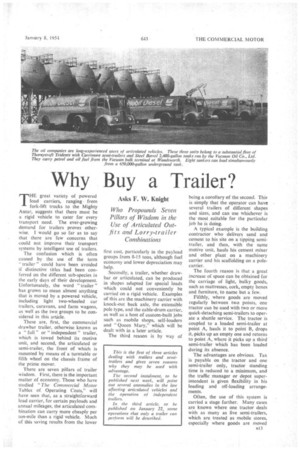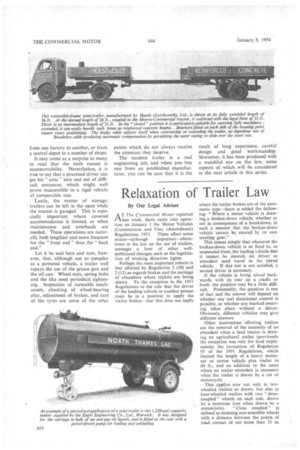Why Buy a Trailer?
Page 47

Page 48

If you've noticed an error in this article please click here to report it so we can fix it.
Asks F. W. Knight
THE great variety of powered load carriers, ranging from fork-lift trucks to the Mighty Antar, suggests that there must be a rigid vehicle to cater for every transport need. The ever-growing demand for trailers proves otherwise. I would go so far as to say that there are few concerns that could not improve their transport systems by intelligent use of trailers.
The confusion which is often caused by the use of the term " trailer" could have been avoided if distinctive titles had been conferred on the different sub-species in the early days of their development. Unfortunately, the word " trailer " has grown to mean almost anything that is moved by a powered vehicle, including light two-wheeled car trailers, caravans, and farm wagons, as well as the two groups to be considered in this article.
These are, first, the commercial drawbar trailer, otherwise known as a " full " or " independent " trailer, which is towed behind its motive unit, and second, the articulated or semi-trailer, the front of which is mounted by means of a turntable or fifth wheel on the chassis frame of the prime mover.
There are seven pillars of trailer wisdom. First, there is the important matter of economy. Those who have studied " The Commercial Motor Tables of Operating Costs," will have seen that, as a straightforward lead carrier, for certain payloads and annual mileages, the articulated combination can carry more cheaply per ton-mile than a rigid vehicle. Much of this saving results from the lower
first cost, particularly in the payload groups from 8-15 tons, although fuel economy and lower depreciation may help.
Secondly, a trailer, whether drawbar or articulated, can be produced in shapes adapted for special loads which could not conveniently be carried on a rigid vehicle. Examples of this are the machinery carrier with knock-out back axle, the extensible pole type, and the cable-drum carrier, as well as a host of custom-built jobs such as mobile shops, self-loaders and "Queen Mary," which will be dealt with in a later article.
The third reason is by way of
being a corollary of the second. This is simply that the operator can have several trailers of different shapes and sizes, and can use whichever is the most suitable for the particular job he is doing,
A typical example is the building contractor who delivers sand and cement to his site on a tipping semitrailer, and then, with the same motive unit, hauls his cement mixer and other plant on a machinery carrier and his scaffolding on a polecarrier.
The fourth reason is that a great increase of space can be obtained for the carriage of light, bulky goods, such as mattresses, cork, empty boxes and furniture, to name but a few.
Fifthly, where goods are moved regularly between two points, one tractor can be used with two or more quick-detaching semi-trailers to operate a shuttle service. The tractor is coupled to a loaded semi-trailer at point A, hauls it to point B, drops it,Ticks up an empty one and returns to point A, where it picks up a third semi-trailer which has been loaded during its absence.
The advantages are obvious. Tax is payable on the tractor and one semi-trailer only, tractor standing time is reduced to a minimum, and the traffic manager or depot superintendent is given flexibility in his loading and off-loading arrangements.
Often, the use of this system is carried a stage further. Many cases are known where one tractor deals with as many as five semi-trailers, which are treated as mobile stores, especially where goods are moved from one factory to another, or from a central depot to a number of shops.
It may come as a surprise to many to read that the sixth reason is manoeuvrability. Nevertheless, it is true to say that a practised driver can get his " artic " into and out of difficult entrances, which might well prove inaccessible to a rigid vehicle of comparable size.
Lastly, the matter of storage; trailers can be left in the open while the tractor is garaged. This is especially important where covered accommodation is limited, or when maintenance and overhauls are needed. These operations are naturally both lengthier and more frequent for the "front end" than the "back end."
Let it be said here and now, however, that, although not so complex as a powered vehicle, a trailer well repays the use of the grease gun and the oil can. Wheel nuts, spring bolts and the like need periodical tightening. Inspection of turntable mechanism, checking of wheel-bearing play, adjustment of brakes, and care of the tyres are some of the other points which do not always receive the attention they deserve.
The modern trailer is a real engineering job, and when you buy one from an established manufacturer, you can be sure that it is the result of long experience, careful design and good workmanship. Moreover, it has been produced with• a watchful eye on the law, some aspects of which will be considered in the next article in this series.




































































































